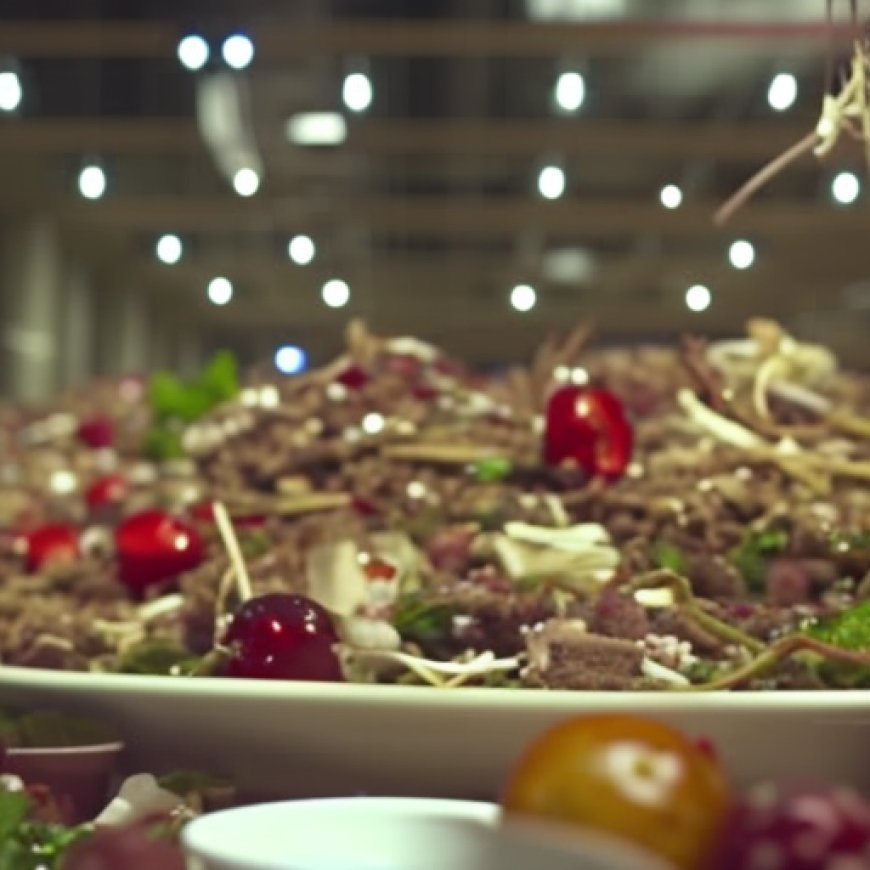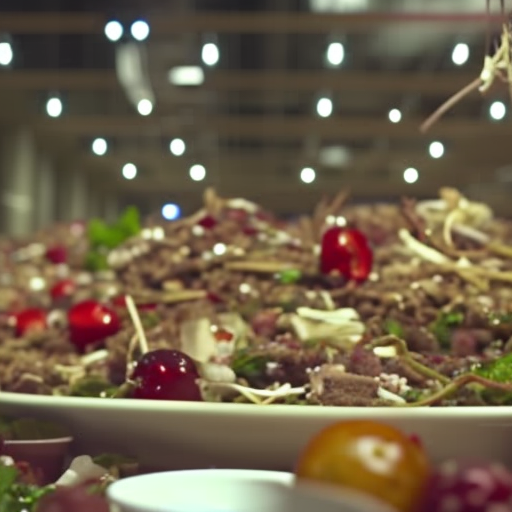Hong Kong’s food waste recycling schemes need more resources, guidance
Hong Kong’s food waste recycling schemes need more resources, guidance YP


Deep Dive: Hong Kong Residents and Restaurant Owners Slow to Recycle Food Waste
Deep Dive delves into hot issues in Hong Kong and mainland China. Our easy-to-read articles provide context to grasp what’s happening, while our questions help you craft informed responses. Check sample answers at the end of the page.
Sustainable Development Goals (SDGs)
- Goal 12: Responsible Consumption and Production
- Goal 13: Climate Action
- Goal 14: Life Below Water
- Goal 15: Life on Land
Introduction
Hong Kong residents and restaurant owners have been slow to recycle food waste because of the absence of incentives and impractical guidelines, lawmakers and industry representatives have said.
Despite years of effort by environmental authorities, many are still unclear about what is fit to recycle, find separating food waste too much of a bother, or do not know where to bin it.
For years, authorities have encouraged people to separate and dispose of such waste appropriately. The city implemented a food waste collection trial scheme in public rental housing estates, using smart recycling bins to reduce food waste in landfills. The collected food waste was then delivered to government recycling facilities to be turned into energy or resources.
The government noted that disposing of biodegradable food waste in landfills is not sustainable or environmentally friendly. It depletes limited space, causes odour, produces harmful gases, and wastes valuable organic materials.
Current Situation
Although food waste collection bins have appeared in some housing estates, some districts have none.
The Environmental Protection Department said it was on track to install more than 700 food waste bins in all 213 public rental housing estates by August, covering a third of Hong Kong’s households.
The department said the amount of food waste it handled rose by 30 per cent last year to about 60,800 tonnes, with more than 90 per cent coming from commercial and industrial sources.
Still, out of 3,000 restaurants invited to use food waste collection points set up at 49 refuse stations, only 11 per cent did so last month.
Simon Wong Ka-wo, president of the Hong Kong Federation of Restaurants and Related Trades, said most outlets were independent, family-run businesses and found it hard to recycle food waste.
“They don’t have the space and staff to separate usable food waste from a pile of non-food and unrecyclable items, such as bones and cutlery,” he said. “Ordinary people and restaurant owners may not be able to comprehend the guidelines.”
Recyclable food waste includes everything from rice and noodles to meat, poultry, fruit and vegetables, pastries, dim sum items, coffee grounds and tea leaves. But large animal bones, crab and seafood shells, corn cobs, young coconuts, durian husks, watery soup, porridge and food packaging are not considered fit for recycling.
Issue: Lack of Access to Bins, Fears Over Costs Affect Food Waste Disposal
- Hong Kong has 449 public food waste bins across the city, but many private housing estates have none
- Some worry about the impact of the upcoming rubbish charging scheme on the ability to recycle food waste
Lack of access to bins and concerns about Hong Kong’s upcoming waste charging scheme has impacted the government’s efforts to encourage people to recycle their food waste.
In response to lawmakers’ inquiries in January, the Environment and Ecology Bureau said Hong Kong had 449 public food waste bins across the city. Sha Tin had 62 bins, the most of any district.
However, no food waste bins were available at private housing estates in Central and Western, Southern, Sham Shui Po and Tai Po districts. There were none in Wan Chai and Yau Tsim Mong districts.
Lawmaker Scott Leung Man-kwong, of the Kowloon West geographical constituency, said there was no food waste recycling facility at Yau Ma Tei Fruit Market. As a result, vendors at the city’s largest wholesale fruit market dumped their unsold and damaged products as regular garbage.
While the government targeted larger housing estates with more than 1,000 flats, he said there were very few of that size in Yau Tsim Mong, so there were no food waste collection points.
He suggested the government subsidise smaller housing estates to help them buy their own bins.
Lawmaker Edward Leung Hei, of the Hong Kong Island East geographical constituency, pointed out that residential areas in Wan Chai primarily consist of single buildings, which do not meet the requirement to apply for free food waste bins.
A pilot scheme for private housing estates began last December, but it only allowed buildings with at least 1,000 flats to apply for a food waste bin.
Even though environmental authorities have recently noted that multiple single buildings could apply for a bin together, he added that it would still be challenging: “No one wants their place to turn into a dumpster.”
He suggested lowering the 1,000-flat bar and allowing the bins to be placed in public areas such as back alleys.
In addition, ahead of the implementation of Hong Kong’s waste charging scheme in August, about a quarter of respondents to a survey about the levy have said they may flush their food waste down the toilet to save costs.
The Society for Community Organisation (SoCO) surveyed more than 300 low-income families in February and found that more than 70 per cent were worried about the extra financial burden, both from paying for the bags and being charged extra fees by landlords to cover the increased workload of cleaners.
The NGO said the government should provide more support to low-income families, for example, by expanding its recycling network and giving out free bags during the transition period.
Glossary:
- Smart recycling bins: special bins equipped with overflow prevention and odour reduction devices that collect food waste and maintain environmental hygiene. They can also measure and record the weight of recyclables automatically.
- Biodegradable: able to decay naturally and in a way that is not harmful to the environment
- Environmental Protection Department: the department of the Hong Kong government responsible for developing and enforcing policies to protect the environment, including nature conservation, the collection, transfer, treatment and disposal of waste, and pollution complaints.
SDGs, Targets, and Indicators
| SDGs | Targets | Indicators |
|---|---|---|
| SDG 12: Responsible Consumption and Production | Target 12.3: By 2030, halve per capita global food waste at the retail and consumer levels and reduce food losses along production and supply chains, including post-harvest losses | Indicator 12.3.1: Food loss index |
| SDG 13: Climate Action | Target 13.3: Improve education, awareness-raising, and human and institutional capacity on climate change mitigation, adaptation, impact reduction, and early warning | Indicator 13.3.1: Number of countries that have integrated mitigation, adaptation, impact reduction, and early warning measures into primary, secondary, and tertiary curricula |
| SDG 15: Life on Land | Target 15.2: By 2020, promote the implementation of sustainable management of all types of forests, halt deforestation, restore degraded forests, and substantially increase afforestation and reforestation globally | Indicator 15.2.1: Progress towards sustainable forest management |
1. Which SDGs are addressed or connected to the issues highlighted in the article?
SDG 12: Responsible Consumption and Production
The article discusses the slow progress in recycling food waste in Hong Kong due to the absence of incentives and impractical guidelines. This aligns with SDG 12, which aims to ensure sustainable consumption and production patterns.
SDG 13: Climate Action
The article mentions that disposing of biodegradable food waste in landfills is not sustainable or environmentally friendly. This connects to SDG 13, which focuses on taking urgent action to combat climate change and its impacts.
SDG 15: Life on Land
The article highlights the need for sustainable management of forests and the impact of food waste on landfills. This relates to SDG 15, which aims to protect, restore, and promote sustainable use of terrestrial ecosystems.
2. What specific targets under those SDGs can be identified based on the article’s content?
Target 12.3: By 2030, halve per capita global food waste at the retail and consumer levels and reduce food losses along production and supply chains, including post-harvest losses
The article discusses the slow progress in recycling food waste in Hong Kong, indicating a need to reduce food waste at the consumer level.
Target 13.3: Improve education, awareness-raising, and human and institutional capacity on climate change mitigation, adaptation, impact reduction, and early warning
The article mentions the need for education and awareness-raising about the environmental impact of food waste disposal in landfills.
Target 15.2: By 2020, promote the implementation of sustainable management of all types of forests, halt deforestation, restore degraded forests, and substantially increase afforestation and reforestation globally
The article highlights the importance of sustainable forest management in addressing the issue of food waste disposal.
3. Are there any indicators mentioned or implied in the article that can be used to measure progress towards the identified targets?
Indicator 12.3.1: Food loss index
The article discusses the slow progress in recycling food waste, indicating a need to measure and reduce food loss at the consumer level.
Indicator 13.3.1: Number of countries that have integrated mitigation, adaptation, impact reduction, and early warning measures into primary, secondary, and tertiary curricula
The article mentions the need for education and awareness-raising about climate change mitigation and adaptation, suggesting the importance of integrating these measures into educational curricula.
Indicator 15.2.1: Progress towards sustainable forest management
The article highlights the importance of sustainable forest management in addressing the issue of food waste disposal, indicating a need to measure progress in this area.
Table: SDGs, Targets, and Indicators
| SDGs | Targets | Indicators |
|---|---|---|
| SDG 12: Responsible Consumption and Production | Target 12.3: By 2030, halve per capita global food waste at the retail and consumer levels and reduce food losses along production and supply chains, including post-harvest losses | Indicator 12.3.1: Food loss index |
| SDG 13: Climate Action | Target 13.3: Improve education, awareness-raising, and human and institutional capacity on climate change mitigation, adaptation, impact reduction, and early warning | Indicator 13.3.1: Number of countries that have integrated mitigation, adaptation, impact reduction, and early warning measures into primary, secondary, and tertiary curricula |
| SDG 15: Life on Land | Target 15.2: By 2020, promote the implementation of sustainable management of all types of forests, halt deforestation, restore degraded forests, and substantially increase afforestation and reforestation globally | Indicator 15.2.1: Progress towards sustainable forest management |
Behold! This splendid article springs forth from the wellspring of knowledge, shaped by a wondrous proprietary AI technology that delved into a vast ocean of data, illuminating the path towards the Sustainable Development Goals. Remember that all rights are reserved by SDG Investors LLC, empowering us to champion progress together.
Source: scmp.com

Join us, as fellow seekers of change, on a transformative journey at https://sdgtalks.ai/welcome, where you can become a member and actively contribute to shaping a brighter future.







